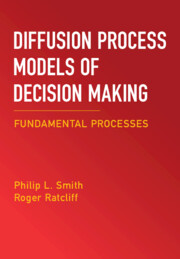Book contents
- Frontmatter
- Dedication
- Contents
- List of Figures
- Preface
- 1 Overview
- 2 Basic Concepts and Data
- 3 Sequential-Sampling Models of Decision Making
- 4 Obtaining Predictions for Diffusion Models
- 5 Empirical Assessment of Sequential-Sampling Models
- 6 Time-Varying Diffusion Models, I. Time Pressure, Urgency, Collapsing Boundaries, and Optimality
- 7 Diffusion Models for Time-Controlled Processing Tasks
- 8 Time-Varying Diffusion Models, II. Detection and Simple RT
- 9 Diffusion Processes Driven by Time-Varying Stimulus Representations in Visual Working Memory
- 10 Neural Diffusion Models, I. Network and Dynamical System Models
- 11 Neural Diffusion Models, II. Poisson Shot Noise and Related Models
- 12 Diffusion Models for Continuous-Outcome Decision Tasks
- 13 Response Confidence
- 14 EZ and Moment Models, Multialternative Decisions, and Expanded Judgment Tasks
- References
- Index
11 - Neural Diffusion Models, II. Poisson Shot Noise and Related Models
Published online by Cambridge University Press: 26 October 2025
- Frontmatter
- Dedication
- Contents
- List of Figures
- Preface
- 1 Overview
- 2 Basic Concepts and Data
- 3 Sequential-Sampling Models of Decision Making
- 4 Obtaining Predictions for Diffusion Models
- 5 Empirical Assessment of Sequential-Sampling Models
- 6 Time-Varying Diffusion Models, I. Time Pressure, Urgency, Collapsing Boundaries, and Optimality
- 7 Diffusion Models for Time-Controlled Processing Tasks
- 8 Time-Varying Diffusion Models, II. Detection and Simple RT
- 9 Diffusion Processes Driven by Time-Varying Stimulus Representations in Visual Working Memory
- 10 Neural Diffusion Models, I. Network and Dynamical System Models
- 11 Neural Diffusion Models, II. Poisson Shot Noise and Related Models
- 12 Diffusion Models for Continuous-Outcome Decision Tasks
- 13 Response Confidence
- 14 EZ and Moment Models, Multialternative Decisions, and Expanded Judgment Tasks
- References
- Index
Summary
Chapter 11 is the second of two chapters that link diffusion models to neural processes. The models in Chapter 10 obtained diffusion processes in a top-down way, by adding noise to smooth network dynamics. The models in Chapter 11 obtain them in a more explicit, bottom-up way, from the flux of postsynaptic potentials induced by sequences of action potentials. This leads to a Poisson shot noise model of stimulus representations. The instantaneous evidence entering the decision process, from aggregating such processes, approximates an Ornstein–Uhlenbeck (OU) velocity process and the accumulated evidence approximates an OU displacement process, The response time distributions of the OU displacement process closely approximate those of Wiener diffusion on long time scales. A second shot noise model assumes that evidence is accumulated in recurrent, or reverberation, loops, which leads to an OU velocity process with linearly increasing drift rates. Both models provide good accounts of response time and accuracy data. The chapter also describes the linear integrated threshold model of motor activation, which leads to an integrated OU model of motor activation, and the linear-drift, linear-infinitesimal variance (LDLIV) model of evidence accumulation.
Information
- Type
- Chapter
- Information
- Diffusion Process Models of Decision MakingFundamental Processes, pp. 287 - 342Publisher: Cambridge University PressPrint publication year: 2025
